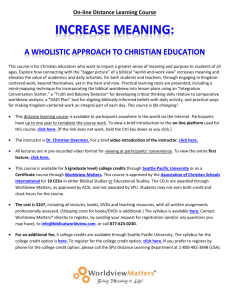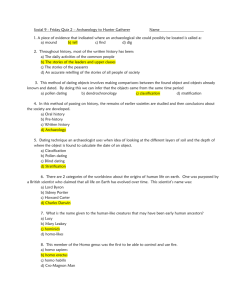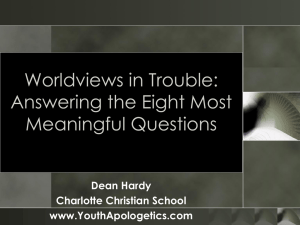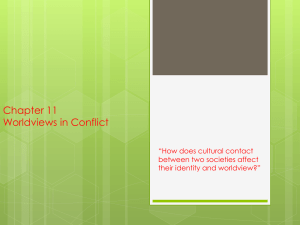Worldview, Challenge of Contextualization and Church Planting By
advertisement
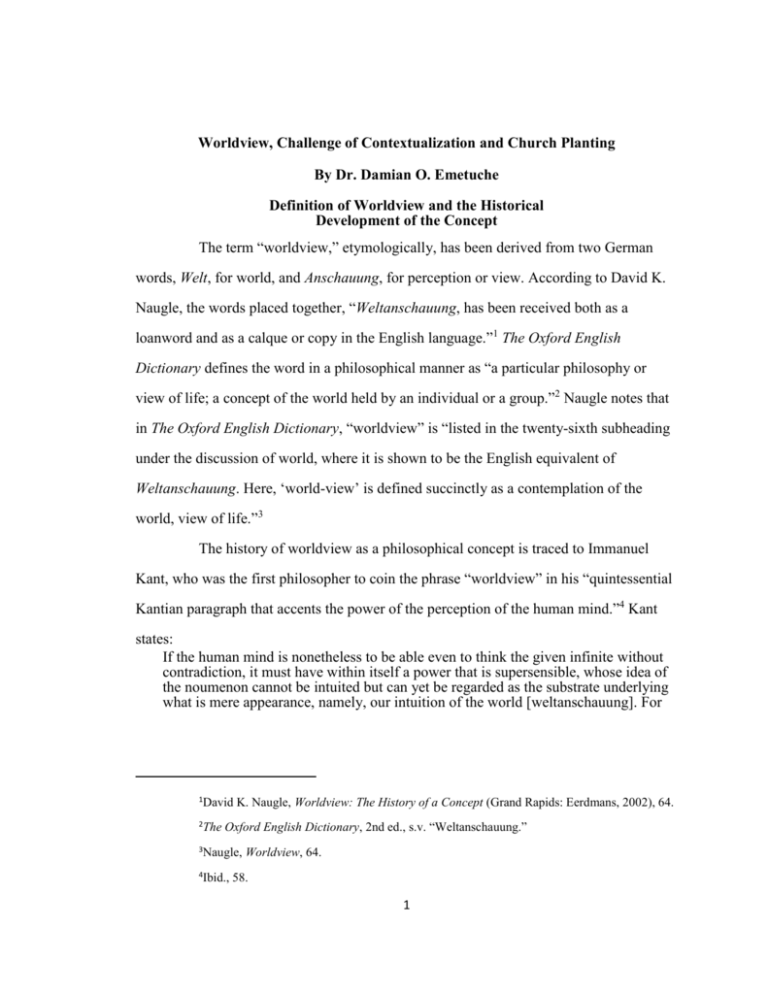
Worldview, Challenge of Contextualization and Church Planting By Dr. Damian O. Emetuche Definition of Worldview and the Historical Development of the Concept The term “worldview,” etymologically, has been derived from two German words, Welt, for world, and Anschauung, for perception or view. According to David K. Naugle, the words placed together, “Weltanschauung, has been received both as a loanword and as a calque or copy in the English language.”1 The Oxford English Dictionary defines the word in a philosophical manner as “a particular philosophy or view of life; a concept of the world held by an individual or a group.”2 Naugle notes that in The Oxford English Dictionary, “worldview” is “listed in the twenty-sixth subheading under the discussion of world, where it is shown to be the English equivalent of Weltanschauung. Here, ‘world-view’ is defined succinctly as a contemplation of the world, view of life.”3 The history of worldview as a philosophical concept is traced to Immanuel Kant, who was the first philosopher to coin the phrase “worldview” in his “quintessential Kantian paragraph that accents the power of the perception of the human mind.”4 Kant states: If the human mind is nonetheless to be able even to think the given infinite without contradiction, it must have within itself a power that is supersensible, whose idea of the noumenon cannot be intuited but can yet be regarded as the substrate underlying what is mere appearance, namely, our intuition of the world [weltanschauung]. For 1 David K. Naugle, Worldview: The History of a Concept (Grand Rapids: Eerdmans, 2002), 64. The Oxford English Dictionary, 2nd ed., s.v. “Weltanschauung.” 2 3 Naugle, Worldview, 64. 4 Ibid., 58. 1 only by means of this power and its idea do we, in a pure intellectual estimation of magnitude, comprehend the infinite in the world of sense entirely under a concept, even though in a mathematical estimation of magnitude by means of numerical concepts we can never think it in its entirety.5 Naugle notes that Kant’s use of the word Weltanschauung simply refers to the sense of perception, and there was nothing remarkable in its use. Nevertheless, the concept was taken by other philosophers from its German origin and carried over to other European languages.6 Again, according to Naugle, “The textual apparatus indicates it [worldview] was first used in English in 1858 by J. Martineau in his book Studies of Christianity, where he refers to ‘The deep penetration of his [Saint Paul’s] mistaken world-view.”7 The second citation of the phrase “worldview” in English, Naugle observes, dates from 1906 in D. S. Cairns’ Christianity in the Modern World, in which he states, “Christianity, alike in its central Gospel, and its World-view, must come to terms with Hellenism.”8 Furthermore, Naugle states: Thus within sixty-eight years of the inaugural use in Immanuel Kant’s Critique of Judgment, Weltanschauung entered the English language in its naturalized form as ‘world-view.’ Ten years later the German word itself gained currency in AngloAmerican academic discourse. Since their middle nineteenth-century beginnings, both Weltanschauung and ‘world-view’ have flourished and became significant terms in the thought and vocabulary of thinking people in the English-speaking world.9 Consequently, the term “worldview” gradually has developed into a technical word that in the last three decades has become a significant term in philosophical and 5 Ibid., 58-59. See also Immanuel Kant, Critique of Judgment: Including the First Introduction, trans. Werner S. Pluhar (Indianapolis: Hackett, 1987), 111-12. 6 Kant, Critique of Judgment, 111-12. See Naugle, Worldview, for more on the concept’s history and development. Naugle, Worldview, 64-65. To read more on Martineau’s use of “worldview,” see James Martineau, Studies in Christianity (Whitefish, MT: Kessinger, 2003). 7 8 Naugle, Worldview, 65. See D. S. Cairns, Christianity in the Modern World (London: Hodder and Stoughton, 1907). 9 Naugle, Worldview, 64-65. 2 theological, as well as in anthropological discourse. Each discipline has to interpret worldview from its particular perspective. Multi-Disciplinary Understanding of Worldview James W. Sire examines the concept from philosophical and theological perspectives and defines worldview in ontological categories. He defines worldview as: A commitment, a fundamental orientation of the heart, that can be expressed as a story or in a set of presuppositions (assumptions) which may be true, or entirely false, which we hold (consciously or subconsciously, consistently or inconsistently) about the basic constitution of reality, and that provides the foundation on which we live and move and have our being.10 In his book, Worldviews in Conflict: Choosing Christianity in a World of Ideas, Ronald Nash agrees with Sire. Nash argues that worldview is a “conceptual scheme by which we consciously or unconsciously place or fit everything we believe and by which we interpret and judge reality.”11 Therefore, he concludes that all mature rational human beings have worldviews. Yet, a worldview may not be articulated or arranged in a philosophical pattern as in the thoughts of Plato and Aristotle. Nevertheless, it is the lens by which each individual, community, and ethno-linguistic group perceives reality. In the same manner, Nash advocates that Christian faith should be seen as a worldview, a “conceptual system, as a total world and life-view. Once people understand that both Christianity and its adversaries in the world of ideas are worldviews, they will be in [a] better position to judge the relative merits of the total Christian system.”12 Nash notes that it is worldview difference that accounts for the multitude of disagreements in societies. He states, “Many disagreements among individuals, societies, and nations are 10 James W. Sire, Naming the Elephant: Worldview as a Concept (Downers Grove, IL: InterVarsity, 2004), 122. 11 Ronald H. Nash, Worldviews in Conflict: Choosing Christianity in a World of Ideas (Grand Rapids: Zondervan, 1992), 16. 12 Ibid., 19-20. 3 clashes of competing worldviews. This is certainly the case between advocates of the prolife and pro-choice positions on abortion. It is also true with regard to the growing number of conflicts between secular humanists and religious believers.”13 Naugle regrets the lack of attention given to weltanschauung and worldview in English encyclopedias and dictionaries of philosophy. However, in the social sciences and theological discussions, the idea of “worldview” has attracted much in-depth study.14This worldview study is particularly true in cultural anthropology, where the concept of worldview is treated as part of cultural phenomena. Much has also been written in other social sciences, for instance in sociology in respect to culture. Sociologists have helped to identify different components of culture, such as symbols, language, values, beliefs, norms, and material culture.15 Sociologists have also immensely contributed to an understanding of the social dynamics of how people interact and organize their societies. Nevertheless, for the purpose of this research, worldview will be considered from the cultural anthropological perspective. However, considering worldview from the perspective of cultural anthropology is not to overlook the importance of the concept in theology, philosophy, and social sciences; but since this study relates to a culturally distinct people, “worldview” from the perspective of cultural anthropology would better serve its purpose. 13 Ibid., 19-20. 14 See Naugle, Worldview, 65. 15 John J. Macionis, Sociology, 9th ed. (Upper Saddle River, NJ: Prentice Hall, 2003), 63. 4 Culture and Worldview James L. Peacock observes that anthropologists “have promiscuously showered affection on the notion of culture, a notion so obvious in their experience and so central to their discipline. Yet they have never agreed on a single definition.”16 For Eugene Nida, “Culture is all learned behavior which is socially acquired, that is, the material and nonmaterial traits which are passed on from one generation to another. They are both transmittable and accumulative, and they are cultural in the sense that they are transmitted by society, not by genes.”17 According to Stephen Grunlan and Marvin Mayers, culture must involve learned and shared attitudes, values, and ways of behaving.18 Hiebert considers culture as “more or less integrated systems of ideas, feelings, and values and their associated patterns of behavior and products shared by a group of people who organize and regulate what they think, feel, and do.”1919 From the observations of Nida, Grunlan, Mayers, and Hiebert cited above, it may be concluded that culture is learned rather than inherited; it is social, shared, and unique to humanity. In her book Globe-Trotting in Sandals: A Guide to Cultural Research, Carol V.McKinney argues that worldview has been used with a multitude of meanings. One of the common usages is in reference to a point of view, a way of looking at an issue or a perspective. McKinney observes that worldview, when used in an ideological sense, contrasts the nature of God theologically with humanistic, materialistic ideologies like secular humanism, Marxism, naturalism, or secularism.20 16 James L. Peacock, The Anthropological Lens: Harsh Light, Soft Focus (Cambridge: University Press, 1986), 3. 17 Eugene Nida, Customs and Cultures: Anthropology for Christian Missions (Pasadena, CA: William Carey Library, 1979), 28. 18 Stephen Grunlan and Marvin Mayers, Cultural Anthropology, 2nd ed. (Grand Rapids: Zondervan Academic, 1988), 39-51. 19 Paul G. Hiebert, Anthropological Insights for Missionaries (Grand Rapids, Baker, 1985), 30. 20 Carol V. McKinney, Globe-Trotting in Sandals: A Guide to Cultural Research (Dallas: SIL International, 2000), 208. 5 However, from the anthropological perspective, worldview is the underlying assumption about reality. The worldview of a culture reveals its basic assumptions about reality at a high level, the macro or metatheoretical level; it is the framework, which provides consistency, more or less, and coherency in the way a people looks at the world.21 Sherwood Lingenfelter writes, “Worldview is fundamentally a system of ideas, of logical relationships, through which actors in a sociocultural arena explain and rationalize their thoughts and actions.”22 As to the relationship of worldview and culture, Lingenfelter again observes, “The unique history, whether written or oral, of each society frames the foundation categories, propositions, cosmology, and explanatory events of its worldview.”2323 In other words, the unique history creates relationships and connects ideas and meanings into noncontradictory propositions. McKinney suggests two differing theoretical approaches in the study of worldview. The first is to examine the content, which necessarily describes specific assumptions in the culture, while the second looks at the structure with the intention of understanding its basic categories.24 Brian J. Walsh and J. Richard Middleton, in their book The Transforming Vision: Shaping a Christian Worldview, argue, “World views are best understood as we see them incarnated, fleshed out in actual ways of life. They are not systems of thought, like theologies or philosophies. Rather, world views are perceptual frameworks.”25 21 Ibid. 22 Sherwood Lingenfelter, Agents of Transformation: A Guide for Effective Cross-Cultural Ministry (Grand Rapids: Baker, 1996), 220. 23 Ibid. 24 McKinney, Globe-Trotting in Sandals, 208. 25 Brian J. Walsh and J. Richard Middleton, The Transforming Vision: Shaping a Christian Worldview (Downers Grove, IL: InterVarsity, 1984), 17 6 Culture is seen as pieces of a puzzle in which worldview is the key in solving or understanding it. Again, Walsh and Middleton write: When we look at a culture, we are looking at the pieces of a puzzle. We can see the functioning of assorted institutions, like the family, government, schools, cultic institutions (churches, temples, synagogues, and so on) and businesses. We can observe different modes of recreation, different sports, transportation and eating habits. Each culture develops a unique artistic and musical life. All of these cultural activities are pieces of the puzzle. The question is, how do we put the puzzle together?How do the pieces interrelate? What is the pattern of the culture? Is there a key that unlocks the pattern? Yes. The central element which brings the pieces of the puzzle together into a coherent whole, is the worldview that has the leading role in the life of that culture.26 Worldview therefore is central to every culture. Charles H. Kraft agreed to the centrality of worldview in every culture. He states, “Worldview, the deep level of culture, is the culturally structured set of assumptions (including values and commitments/allegiances) underlying how a people perceive and respond to reality.”27 Furthermore, Kraft contends that “worldview is not separate from culture. It is included in culture as the deepest level presuppositions upon which people base their lives.”28 In his most famous work, Christianity in Culture: A Study in Dynamic Biblical Theologizing in Cross-Cultural Perspective, Kraft argues that not only does worldview lie at the heart of culture, but it drives the culture, touching, interacting with, and strongly influencing every other aspect of the culture.29 As to the foundation of worldview, Kraft writes: 26 Ibid., 18-19. Charles H. Kraft, “Culture, Worldview and Contextualization,” in Perspectives on the World Christian Movement: A Reader, ed. Ralph D. Winter and Steven C. Hawthorne (Pasadena, CA: William Carey Library, 1999), 385. It should be noted that the early writers on the theme of “intercultural communications” of the gospel used the phrase “cross-cultural” to mean “intercultural.” This can be seen in books and materials written by authors like Kraft, Nida, Hiebert, Lingenfelter, McKinney, and Hesselgrave, among others. New writers, like Everett Rogers and Thomas Steinfatt prefer the phrase “intercultural.” In contemporary missiological writings, “intercultural” communication of the gospel signifies communicating the gospel from one culture to another culture, while “cross-cultural communication” now has the significance of that which is true, or common to every culture. In this research, we will be using the phrase “intercultural,” unless in a direct quotation from another author. 27 28 Ibid. 29 Charles H. Kraft, Christianity in Culture: A Study in Dynamic Biblical Theologizing in Cross-Cultural Perspective (Maryknoll, NY: Orbis, 1979), 53. 7 The worldview of any given culture presumably originated in a series of agreements by the members of the original group concerning their perception of reality and how they should regard and react toward that reality. This, like all other aspects of culture, has undergone constant change so that it now differs to a greater or lesser extent from the original worldview and from other extant worldviews that have developed (in related cultures) from that common-ancestor worldview. A worldview is imposed upon the young of a society by means of [a] familiar process of teaching and learning. In this way each youngster reared in a given culture is conditioned to interpret reality in terms of the conceptual system of that culture.30 Hiebert identifies three dimensions of culture: (1) Cognitive dimension, which reflects the knowledge shared by the society; (2) Affective dimension, which deals with the attitudes, notions of beauty, tastes in food and dress, likes and dislikes, enjoyments and sharing of sorrows; and (3) Evaluative dimension, which is concerned with values, standards by which human relationships are judged, sense of right and wrong, truth and falsehood.31 Hiebert’s evaluative dimension of culture corresponds to Kraft’s understanding of worldview. The Willowbank Report states. Culture holds people together over a span of time. It is received from the past, but not by any process of natural inheritance. Culture has to be learned afresh by each generation. This [enculturation] takes place broadly by the process of absorption from the social environment, especially in the home. In many societies, certain elements of the culture are communicated directly in rites of initiation, and by many other forms of deliberate instruction.32 Furthermore, “At its center is a worldview, that is, a general understanding of the nature of the universe and one’s place in it. This center may be ‘religious’ (concerning God, or gods and spirits, and of our relation to them), or it may express a ‘secular’ concept of reality, as in a Marxist society.”33 30 Ibid. 31 Hiebert, Anthropological Insights for Missionaries, 30-34. “The Willowbank Report: Report of a Consultation on Gospel and Culture,” Lausanne Committee of World Evangelization [on-line]; accessed 12 September 2003; available from http://www. gospelcom.net/lcwe/LOP/lop02.htm, 3; Internet. See also “The Willowbank Report: Report of a Consultation on Gospel and Culture,” in Perspectives on the World Christian Movement: A Reader, 484. 32 33 “The Willowbank Report: Report of a Consultation on Gospel and Culture,” Lausanne Committee for World Evangelization. 8 Consequently, worldview is a way people look at and judge the world; it is their perception of reality. There may be as many worldviews as there are cultures. Each culture looks at the world differently, and its perception determines to a certain extent how the gospel is presented to that culture. Unless there is a good grasp of a people’s worldview, sharing the gospel in a way that will have a lasting impact in their culture will be difficult. It is not that converts will not be made; but there will be certain cultural norms that may not be transformed because of ignorance. Todd Gitlin, in The Twilight of Common Dreams: Why America Is Wracked by Culture Wars, notes, How men and women think is not simply a function of what they have seen or felt in their own lives. Nor is their form of thought a genetic shadow cast by their parents or grandparents. People think within the intellectual and cultural currents that surround them--currents with histories, even if the sources cannot be seen from downstream. Even dissenters are soaked in the currents that they believe themselves to be swimming against. To paraphrase Marx, men and women think, but not in language or concepts or even emotions utterly of their own making.34 Kraft therefore outlined the five major functions of worldview as explanatory, evaluational, psychological reinforcement, integrating, and adaptability. In respect to explanatory, Kraft notes that it is the worldview that embodies the people “whether explicitly or implicitly, the basic assumptions concerning ultimate things on which they base their lives.”35 For instance, If the worldview of a people conditions them to believe that the universe is operated by a number of invisible personal forces largely beyond their control, this will affect both their understanding of and their response to ‘reality.’ If, however, a people’s worldview explains that the universe operates by means of a large number of impersonal, cause-and-effect operations which, if learned by people, can be employed by them to control the universe, the attitude of these people toward ‘reality’ will be much different.36 Concerning the evaluationary function, Kraft states, “The basic institutions, values, and goals of a society are ethnocentrically evaluated as best, and, therefore, sanctioned by the 34 Todd Gitlin, The Twilight of Common Dreams: Why America Is Wracked by Culture Wars (New York: Henry Holt, 1995), 200. See also Everett M. Rogers and Thomas M. Steinfatt, Intercultural Communication (Long Grove, IL: Waveland, 1999), 2. 35 Kraft, Christianity in Culture, 54. 36 Ibid. 9 worldview of their own subculture. Other people’s customs are judged to be inferior or at least inappropriate.”37 As it pertains to psychological reinforcement, Kraft argues that in times of crisis, “It is to one’s conceptual system that one turns for encouragement to continue or the stimulus to take other action.”38 Crises such as death, birth, marriage, and illness serve to reinforce a worldview, as each crisis is resolved in accordance with the customs and traditions of the society. Often, Kraft suggests: This reinforcement takes the form of ritual or ceremony in which many people participate (e.g., funerals, harvest celebrations, initiation or graduation ceremonies). Frequently there are also individual worldview-required reinforcement observances such as prayer, trance, scientific experimentation, or ‘thinking the matter through’ for the purpose of squaring a prospective decision with one’s conceptual underpinning.39 Furthermore, worldview serves to integrate different aspects of the culture into a whole, systematic order, and organizes the cultural perception of reality into an overall design. In terms of this integrated and integrating perspective, Kraft observes, “A people conceptualizes what reality should be like and understands and interprets the multifarious events to which they are exposed.”40 In addition to its integrating function, worldview also serves in adaptation. People, by “adjusting to their worldviews, devise means for resolving conflict and reducing cultural dissonance. That is, in circumstances of cultural distortion or disequilibrium there is a resilient quality to worldviews by means of which people 37 Ibid., 55. 38 Ibid. 39 Ibid. 40 Ibid., 56. 10 reconcile hitherto apparently irreconcilable differences between old understandings and new ones.”41 In Anthropological Reflections on Missiological Issues, Hiebert notes, “Growing awareness of the fundamental differences between cultures has raised a host of new questions about cross-cultural communication, incarnational ministries, contextualization, and the relationship between theology and sociocultural contexts.”42 One may also add church planting methodology and the issue of syncretism to the lists of questions. In many cases, Hiebert observes: Emphasis on anthropology and social sciences has led to the neglect of theology in mission endeavor. A generation ago, most books and articles dealt with the nature of God’s call, lostness of humanity, the need for prayer and faithfulness, and the radical challenge of such old customs as widow burning and human sacrifice. Today, publications deal with planning, leadership, cultural sensitivity, effective sociocultural strategies for evangelism, minimizing cultural dislocation in conversion, and how context determines meaning in the contextualization of theology.43 The focus has now shifted more to pragmatism, an accusation often levied against the Church Growth Movement and contextual theologians. An example of such a book is Jesus in Global Contexts, by Priscilla Pope-Levison and John Levison. The Levisons, writing about the need for contextualized Christology, insist that several developments within Christianity in the global dialogue and theories of interpretation necessitate a conversation on the nature of interpretation.44 Some of the developments include the change in the center of gravity of the Christian faith from the Western world to Latin America, parts of Asia, and Africa. Another factor identified for the imperative of dialogue is the contemporary model of 41 Ibid., 57. 42 Paul G. Hiebert, Anthropological Reflections on Missiological Issues (Grand Rapids: Baker, 1994), 9. 43 Ibid., 9-10. 44 Priscilla Pope-Levison and John Levison, Jesus in Global Contexts (Louisville: Westminster/John Knox, 1992), 12. 11 literary interpretation. Prior to postmodernism, “The task of the scholar has been to uncover the original meaning of the Bible by means of linguistic and historical analysis.”45 However, “This model of monologue has been displaced by the model of dialogue between the text and the interpreter because it is evident that what the Bible says is determined to a great extent by what the interpreter asks.”46The Levisons, citing Robert M. Grant and David Tracey, state. The fact is that no interpreter enters into the attempt to understand any text or historical event without prejudgments formed by the history of the effects of her or his culture. There does not exist any exegete or historian as purely autonomous as the Enlightenment model promised. 47 Therefore, the two theses in support of contextual theologies include: “(1) All theologies are contextually conditioned. . . . (2) It may take others to show us how conditioned, parochial, or ideologically captive our own theology is.”48 In essence, the concern of critics on the relevance of cultural studies and the shift toward pragmatism may be legitimate. Nevertheless, some past missionaries often understood the Scriptures well but not the people they served; and this scenario led to their message not being understood by the people. Consequently, as Hiebert points out: Churches they planted were often alien and, as a result, remained dependent on the outside support for their existence. Missionaries brought with them, not only the gospel, but also Western cultures, and often they failed to differentiate between the two. Many rejected Christ because they rejected the foreignness of the missionary message—not because of the offence of the gospel.49 45 Ibid., 14. 46 Ibid. 47 Ibid., 15. See Robert M. Grant and David Tracey, A Short History of the Interpretation of the Bible, 2nd ed. (Philadelphia: Fortress Press, 1984), 156. 48 Jesus in Global Contexts, 15. 49 Hiebert, Anthropological Reflections on Missiological Issues, 10. 12 Stephen Neill, in Colonialism and Christian Missions, also notes the dilemma of the colonial missionaries in presenting the gospel in culturally relevant manners. He commented: It has always been the aim of the missionary to present to the non-Christian the pure doctrine of Jesus Christ without merely local or cultural adulteration. But this has, in fact, proved impracticable. We are all conditioned by our background and traditions . . . which have little relationship to Christian Gospel.50 In this situation, understanding worldview will help the intercultural missionary understand his or her own culture as well as the culture of the target people and facilitate contextualizing the message of the gospel. Contextualization and Worldviews Many evangelical scholars have addressed the question of contextualization. For instance, Hiebert and Meneses insist, “We must begin by learning to speak the language well so that we can communicate the gospel in the thought forms of the people we serve. If we do not, we risk talking past people by using categories that make no sense to them.”51The term contextualization has been interpreted and defined in various ways, depending on where one is theologically. For those in theological matrixes of Neo-orthodoxy and Neo-liberalism, contextualization could mean “prophetic contextualization,” and the method of contextualization would be “dialectic—discovering truth.” For theological liberals, according to Hesselgrave, contextualization may involve syncretism; and the method employed would be dialogic-- “pursuing truth.”52 However, for the evangelical orthodox, contextualization refers to the “apostolic” biblical examples, and the method of effecting 50 Stephen Neill, Colonialism and Christian Missions (London: Lutterworth, 1966), 415. 51 Paul G. Hiebert and Eloise Hiebert Meneses, Incarnational Ministry: Planting Churches in Band, Tribal, Peasant, and Urban Societies (Grand Rapids: Baker, 1995), 371. 52 David J. Hesselgrave, Communicating Christ Cross-Culturally: An Introduction to Missionary Communication, 2nd ed. (Grand Rapids: Zondervan, 1991), 143. See also David Hesselgrave and Edward Rommen, Contextualization: Meanings, Methods, and Models (Pasadena, CA: William Carey Library, 1989). 13 the contextualization must be didactic, signifying “teaching the truth.” Following the latter approach, Hesselgrave defined contextualization as: The attempt to communicate the message of the person, works, word, and will of God in a way that is faithful to God’s revelation, especially as it is put forth in the teaching of Holy Scripture, and that is meaningful to respondents in their respective cultural and existential contexts.53 Hesselgrave also states that contextualization is both verbal and nonverbal and will affect theology, Bible translation, interpretation and application, lifestyle, evangelism, church planting, church growth, church organization, worship style, and indeed, all the components of Christian mission as reflected in the Great Commission.54 Therefore, to be able to contextualize the gospel in a given culture, a good understanding of the culture and worldview will be required. Dean Flemming, in his book Contextualization in the New Testament, observes, “Although the term contextualization was quite recently minted, the activity of expressing and embodying the gospel in context-sensitive ways has characterized the Christian mission from the very beginning.”5555 Charles Kraft agrees, and states: Contextualization of Christianity is part and parcel of the New Testament record. This is the process that apostles were involved in as they took the Christian message that had come to them in Aramaic language and culture and communicated it to those who spoke Greek.56 For the intercultural church planter, it should be his or her goal to plant churches that would be relevant and be rooted in the culture of the people. In order to achieve this, the understanding of the target culture’s worldview will be imperative. As Kraft suggests, different worldview assumptions will lead to different conclusions. 53 Hesselgrave, Communicating Christ Cross-Culturally, 143. 54 Ibid., 143-44. See also Hesselgrave and Rommen, Contextualization: Meanings, Methods, and Models, 200-11. 55 Dean Flemming, Contextualization in the New Testament: Patterns for Theology and Mission (Downers Grove, IL: InterVarsity, 2005), 15. Kraft “Culture, Worldview and Contextualization,” 389. 56 14 There is a good bit of similarity to human behavior in spite of cultural differences. There is even a considerable body of evidence to suggest that human reasoning processes are essentially the same no matter what one’s culture is. For this reason it has been stated that humans differ not so much in the processes by means of which they reach their conclusions as in their starting points. That is, the members of different cultures arrive at different conclusions concerning reality because they have started from different assumptions.57 Therefore, a clear understanding of a culture and its underlying worldview will be paramount not only in proclamation of the gospel message, but in discipleship and leadership training as well. In short, there will be no genuine contextualization without prior understanding of a culture and its worldview. According to Hiebert, “First, the gospel must be distinguished from all human cultures. It is divine revelation, not human speculation. Since it belongs to no one culture, it can be adequately expressed in all of them.”58 Consequently, all intercultural church planters must recognize not only the challenge of culture, but also the cultural Jewishness of the gospel in its historical setting as well as its supra-cultural nature. Therefore, he calls for “critical contextualization,” a practice “whereby old beliefs and customs are neither rejected nor accepted without examination. They are first studied with regard to meanings and places they have within their cultural setting and then evaluated in the light of biblical norms.”59 As to how the critical contextualization may be realized, Hiebert suggests first a phenomenological exegesis of the culture. This will involve gathering and analyzing the traditional beliefs and customs associated with issues at hand. The second step is the exegesis of the Scripture and the hermeneutical bridge, in which the Christian leader seeks to study the questions at hand, as they relate to the Scripture. The third level is the critical response. Here the people corporately evaluate their customs in the light of 57 Kraft, Christianity in Culture, 57. 58 Hiebert, Anthropological Insights for Missionaries, 53. 59 Ibid., 186. 15 biblical understanding and take a stand on the issue under consideration.60In other words, the critical contextualization must take into consideration the whole culture, and particularly the worldview of a people before true contextualization can be actualized. 60 Hiebert, Anthropological Reflections on Missiological Issues, 88-90. 16
